Phra Phrom
.jpg)
Phra Phrom (Thai: พระพรหม; from Sanskrit: Brahma, ब्रह्म) is the Thai representation of the Hindu god Brahma (the god of the manifested world),[1] who is regarded in Thai culture as a deity of good fortune and protection. According to puranas, Brahma has four faces representing four Vedas or knowledge coming from four directions: north, south, east and west[2]. Phra Phrom is colloquially known outside Thailand as the Four-Faced Awakened One (四面佛, Sìmiànfó) or Four-Faced God (四面神 Simianshen) among Chinese folk religious worshippers, among whom the faith of this god has spread in the latest decades.
Worship
Worshippers of the god usually offer incense, candles, jasmine flowers or jasmine garlands and young coconut milk (with water in them) in their worship, usually placing these offerings before all four heads of Phra Phrom, each head representing a different aspect of the deity; it is believed each side of Phra Phrom offers different blessings. Another common way of worship is to place wooden elephant statues on the altar to honor him. Phra Phrom is also known to admire Thai classical music, which is played near larger scale outdoor altars, accompanied by dancers. For a small fee, the dancers include worshiper's name into the songs they sing while dancing. Worshipers of Phra Phrom are also usually advised to abstain from consuming meat. It is also believed that worshipers have to make good on any promises made to the deity else misfortune will befall them instead of the fortune that was asked for. Items needed for prayers are available in the premises of the shrine.
The main example of this representation of Brahma is the statue at the Erawan Shrine in Bangkok, where the faith of the god has its origins in modern times.[3] The golden dome of the Government House of Thailand also contains a statue of Phra Phrom.
Spread of the cult among Chinese
As early as the 1980s, the popularity of the Erawan cult of Brahma from its inceptions in Thailand spread, accompanied by faithful reproduction of the structure of the shrine and the image, among overseas Chinese in other countries of Southeast Asia (Singapore, Indonesia and Malaysia), in Taiwan, and in China, with shrines established in Hong Kong, Shanghai and Guangzhou.
Gallery
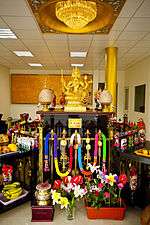 A Chinese altar dedicated to Brahma in Kaohsiung.
A Chinese altar dedicated to Brahma in Kaohsiung.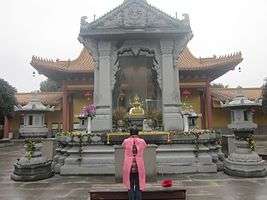
 Brahma statue at the Erawan Shrine, Bangkok
Brahma statue at the Erawan Shrine, Bangkok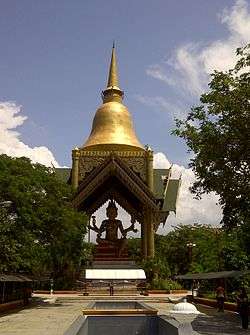
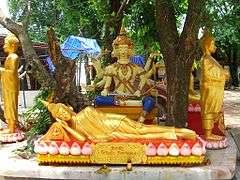 Statue of Brahma in a Laotian Buddhist temple.
Statue of Brahma in a Laotian Buddhist temple.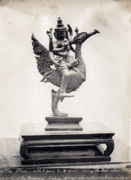 Brahma riding the Hong bird, old statue.
Brahma riding the Hong bird, old statue.
See also
- General articles
References
- ↑ https://www.tourismthailand.org/Attraction/Erawan-Shrine--2140
- ↑ Barbara Holdrege (2012), Veda and Torah: Transcending the Textuality of Scripture, State University of New York Press, ISBN 978-1438406954, pages 88-89
- ↑ http://www.bangkok-traveltips.com/erawan-shrine.htm
External links
| Wikimedia Commons has media related to Statues of Phra Phrom. |